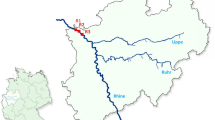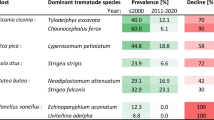Abstract
A long-term study of a molluscan–trematode community in the Basingstoke Canal, UK, was undertaken over the period 1970–2003 which coincided with a significant restoration program involving substantial anthropogenic changes to the canal’s ecosystem. The aim of this study was to correlate these changes with alterations in the molluscan–trematode community, focusing on fluctuations in the prevalence and species richness of the trematode population as a good indicator, in terms of biodiversity, of ecosystem health. Molluscs were sampled at four time periods (1970, 1982, 1983, 2003) and examined for trematode parasites. The molluscan population over the sampling period demonstrated a limited stability with few species being present during all time periods. During 1982 and 1983, when restoration of the sampling site was being undertaken, Lymnaea stagnalis dominated the molluscan fauna, possibly because it was best able to take advantage of the disturbed conditions, while other species such as Bithynia tentaculata were absent. In the trematode population, the prevalence and diversity of both cercarial and metacercarial infections was high in 1970 prior to the period of restoration work. However, during 1982 and 1983, the trematode community was significantly reduced with cercarial prevalence declining to less than 1%. By 2003, more than 12 years after restoration had been completed, the trematode population had shown only a modest recovery. Trematodes use a wide range of different host species for completing their life-cycles and may be used as bioindicators of ecosystem diversity and health. An interpretation of the structure of the molluscan–trematode community over the sampling period suggests that the restoration project had an initial negative effect on ecosystem health, in terms of biodiversity, but this has subsequently only shown modest signs of recovery suggesting continuing problems in ecological functioning and stability.
Similar content being viewed by others
References
Anonymous (1978) Fishing the canal. Basingstoke Canal Newsletter (Surrey and Hampshire Canal Society) 81(Sept). Available: http://www.basingstokecanal.org.uk/bcnews081.htm [accessed May 12, 2006]
Boddeke R (1960) The life history of Prosthogonimus ovatus Rudolphi. II. The intermediate hosts. Tropical Geography and Medicine 12:363–377
Bustnes JO, Galaktionov K (1999) Anthropogenic influences on the infestation of intertidal gastropods by seabird tremastode larvae on the southern Barents Sea coast. Marine Biology 133:449–453
Byfield A (1990) The Basingstoke canal. British Wildlife 2:13–21
Carter SP, Bright PW (2003) Reedbeds as refuges for water voles (Arvicola terrestris) from predation by introduced mink (Mustela vison) Biological Conservation 111:371–376
Chernogorenko MI (1970) Patterns in the establishment of a trematode fauna parasitic on benthic invertebrates in the reservoirs of the Dnepr series. Hydrobiological Journal J 6(1):46–49
Chernogorenko MI (1976) Dynamics of the trematode fauna of molluscs from the Kremenchug Reservoir. Hydrobiological Journal 12(3):36–41
Chernogorenko MI (1977) Trematode fauna of molluscs in the Kremenchug Reservoir. Hydrobiological Journal 13(5):87–94
Costanza R, Mageau M (2000) What is a healthy ecosystem? Aquatic Ecology 33:105–115
Diaz Diaz MT (1976) Studies on the life cycles of digenetic trematodes. PhD thesis, University of Leeds, Leeds, UK
Esch GW, Kennedy CR, Bush AO, Aho JM (1988) Patterns in helminth communities in freshwater fish in Great Britain: alternative strategies for colonization. Parasitology 96:519–532
Ferreras P, MacDonald DW (1999) The impact of American mink Mustela vison on water birds in the upper Thames. Journal of Applied Ecology 36:701–708
Frandsen F, Christensen NO (1984) An introductory guide to the identification of cercariae from African freshwater snails with special reference to cercariae of trematode species of medical and veterinary importance. Acta Tropica 41:181–202
Gaten E (1986) Life cycle of Lymnaea peregra (Gastropoda: Pulmonata) in the Leicester canal, UK, with an estimate of annual production. Hydrobiologia 135:45–54
Gerard C (2001) Consequences of a drought on freshwater gastropod and trematode communities. Hydrobiologia 459:9–18
Hechinger RF, Lafferty KD (2005) Host diversity begets parasite diversity: bird final hosts and trematodes in snail intermediate hosts. Proceedings of the Royal Society of London. Series B: Biological Sciences 272:1059–1066
Holling CS (1973) Resilience and stability of ecological systems. Annual Review of Ecology and Systematics 4:1–23
Hugghins EJ (1956) Ecological studies on a strigeid trematode at Oakwood Lakes, South Dakota. Proceedings of the South Dakota Academy of Sciences 35:204–206
Huspeni TC, Lafferty KD (2004) Using larval trematodes that parasitize snails to evaluate a saltmarsh restoration project. Ecological Applications 14:795–804
Huspeni TC, Hechinger RF, Lafferty KD (2005) Trematode parasites as estuarine indicators: opportunities, applications, and comparisons with conventional community approaches. In: Bortone S (editor) Estuarine Indicators, Boca Raton, FL: CRC Press, pp 297–314
James CS, Eaton JW (1999) The Basingstoke Canal SSSI: Analysis of 1988–1998 Ecological Data and Recommendations for Future Management and Monitoring, Peterborough, UK: English Nature Research Report, 67 p
Jebens D, Robinson D (1985) Basingstoke Canal Restoration, Guilford, UK: Surrey and Hampshire Canal Society, 48 p
Jebens D, Brazier J, Brazier C (editors) (1978–1984) Basingstoke Canal Newsletter (Surrey and Hampshire Canal Society) 81(Sept)–116(July). Available: http://www.basingstoke-canal.org.uk/bcnarchive.htm [accessed May 20, 2006]
Keas BE, Blankespoor HD (1997) The prevalence of cercariae from Stagnicola emarginata (Lymnaeidae) over 50 years in Northern Michigan. Journal of Parasitology 83:536–540
Kennedy CR (1974) A checklist of British and Irish freshwater fish parasites with notes on their distribution. Journal of Fish Biology 6:613–644
Kennedy CR (1993) Introductions, spread and colonization of new localities by fish helminth and crustacean parasites in the British Isles: a perspective and appraisal. Journal of Fish Biology 43:287–301
Kennedy CR (1998) Aquatic birds as agents of parasite dispersal: a field test of the effectiveness of helminth colonisation strategies. Bulletin of the Scandinavian Society for Parasitology 8:23–28
King G (2001) Canals. In: Johnston J (editor) Biodiversity Action Plan for Hampshire, Vol 2, Winchester, UK: Hampshire Biodiversity Partnership and Hampshire County Council, pp 1–14
Kirk RS, Lewis JW (1993) The life-cycle and morphology of Sanguinicola inermis Plehn, 1905 (Digenea: Sanguinicolidae). Systematic Parasitology 25:125–133
Kirk RS, Lewis JW (1994) The distribution and host range of species of the blood fluke Sanguinicola in British freshwater fish. Journal of Helminthology 68:315–318
Lafferty KD, Holt RD (2003) How should environmental stress affect the population dynamics of disease? Ecology Letters 6:654–664
Lodge DM, Kelly P (1985) Habitat disturbance and the stability of fresh-water gastropod populations. Oecologia 68:111–117
Lodge DM, Brown KM, Klosiewski SP, Stein RA, Covich AP, Leathers BK, et al. (1987) Distribution of fresh-water snails—spatial scale and the relative importance of physicochemical and biotic factors. American Malacological Bulletin 5:73–84
Lousley JE (1976) Flora of Surrey, Newton Abbot, UK: David and Charles, p 475
Marcogliese DJ (2003) Food webs and biodiversity: are parasites the missing link? Journal of Parasitology 89(Suppl):106–113
Marcogliese DJ (2005) Parasites of the superorganism: are they indicators of ecosystem health? International Journal for Parasitology 35:705–716
Markevich AP, Iskov MP, Koval VP, Chernogorenko MI (1976) Effect of hydraulic works on the parasite fauna of the Dnieper river. Hydrobiological Journal 12(2):1–6
Mkoji GM, Hofkin BV, Kuris AM, Stewart-Oaten A, Mungai BN, Kihara JH, et al. (1999) Impact of the crayfish Procambarus clarkii on Schistosoma haematobium transmission in Kenya. American Journal of Tropical Medicine and Hygiene 61:751–759
Nasir P (1984) British Freshwater Cercariae, Cumana, Venezuela: Universidad de Oriente, 345 p
Nasir P, Erasmus DA (1964) A key to the cercariae from British freshwater molluscs. Journal of Helminthology 38:245–268
Nature Conservancy Council (1990) The Basingstoke Canal—a Future for Wildlife? A Joint Nature Conservation Strategy, Peterborough, UK: Nature Conservancy Council, p 15
Nystrom P, Perez JR (1998) Crayfish predation on the common pond snail (Lymnaea stagnalis): the effect of habitat complexity and snail size on foraging efficiency. Hydrobiologia 368:201–208
Pinkett AJ (1995) Basingstoke canal hydrological study: a water balance. Journal of the Chartered Institution of Water and Environmental Management 9:376–384
Probert AJ (1965) Studies on larval trematodes infecting the freshwater molluscs of Llangorse Lake, South Wales. Part I. The xiphidio- and microcercous cercariae. Journal of Helminthology 39:35–52
Russell-Hunter WD (1978) Ecology of freshwater pulmonates. In: Pulmonates, Vol 2A: Systematics, Evolution and Ecology, Fretter V, Peake J (editors), New York: Academic Press, pp 335–384
Smith NF (2001) Spatial heterogeneity in recruitment of larval trematodes to snail intermediate hosts. Oecologia 127:115–122
Stenroth P, Nystrom P (2003) Exotic crayfish in a brown water stream: effects on juvenile trout, invertebrates and algae. Freshwater Biology 48:466–475
Van den Berg MS, Coops H, Noordhuis R, van Schie J, Simons J (1997) Macroinvertebrate communities in relation to submerged vegetation in two Chara-dominated lakes. Hydrobiologia 342/343:143–150
Vine PAL (1994) London’s Lost Route to Basingstoke. The Story of the Basingstoke Canal. Stroud, UK: Sutton Publishing, 235 p
West C, Church S (1991) The Basingstoke canal: a wildlife survival strategy. Ecos 12:40–43
Young MR (1973) Studies on the population dynamics of some digeneans parasitizing molluscs in the Worcester-Birmingham canal. PhD thesis, University of Birmingham, Birmingham, UK
Young MR (1974) Seasonal variation in the occurrence of Chaetogaster limnaei limnaei Gruffydd (Oligochaeta) in two of its molluscan hosts in the Worcester-Birmingham canal and its relationship with the digenean parasites of these molluscs. Journal of Natural History 8:529–535
Young MR (1975) The life cycles of six species of freshwater molluscs in the Worcester-Birmingham canal. Proceedings of the Malacological Society of London 41:533–548
Author information
Authors and Affiliations
Corresponding author
Rights and permissions
About this article
Cite this article
Morley, N.J., Lewis, J.W. Anthropogenic Pressure on a Molluscan–Trematode Community over a Long-term Period in the Basingstoke Canal, UK, and Its Implications for Ecosystem Health. EcoHealth 3, 269–280 (2006). https://doi.org/10.1007/s10393-006-0058-0
Published:
Issue Date:
DOI: https://doi.org/10.1007/s10393-006-0058-0




